
Cotehele and the Legend of the Chapel in the Woods
During the fourteenth century, marrying an heiress was a great way for young men to enhance their wealth and future prospects. In 1353, William Edgecombe seized such an opportunity when he married Hilaria de Cotehele. As a result of their union, William acquired extensive lands, including a substantial manor that overlooked the picturesque River Tamar, situated near Calstock in Cornwall.
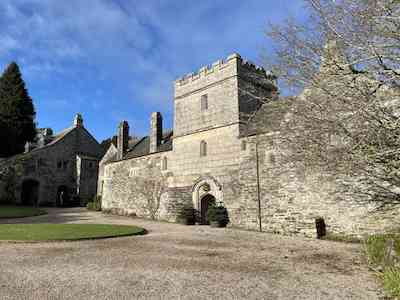
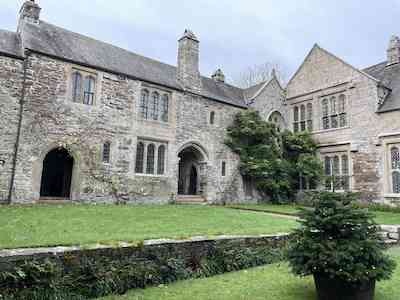
The family thrived, partly due to the profits from lead and silver mining. During the fifteenth century, the old house on the property was demolished and reconstructed using granite and slate. Later, Richard Edgecumbe would make good use of his reward from Henry VII after the battle of Bosworth to enlarge and update the place. Now in the care of the National Trust, Cotehele boasts a fascinating collection of buildings centred around a magnificent Great Hall and a courtyard, with a Chapel added in 1411. Stepping across its threshold, you are instantly transported into the past.
Since 1956, each year the gardeners of Cotehele have made a magnificent 60-foot garland using countless flowers cultivated on the estate. This glorious garland graces the Great Hall throughout the Christmas season.
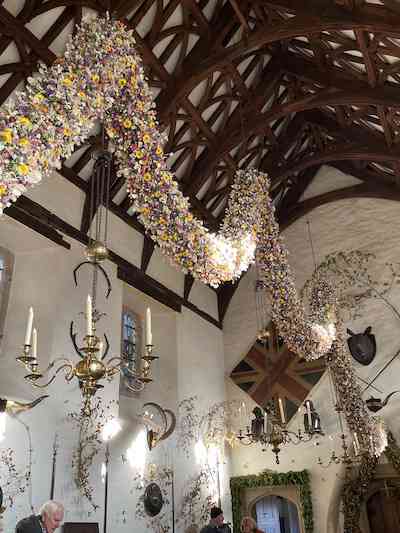
But many of the visitors who flock to see the house decked out in its festive best each December are probably unaware of a hidden gem nestled within the grounds. Perched on a high bank overlooking the Tamar River, lies a quaint chapel with a fascinating tale to share.
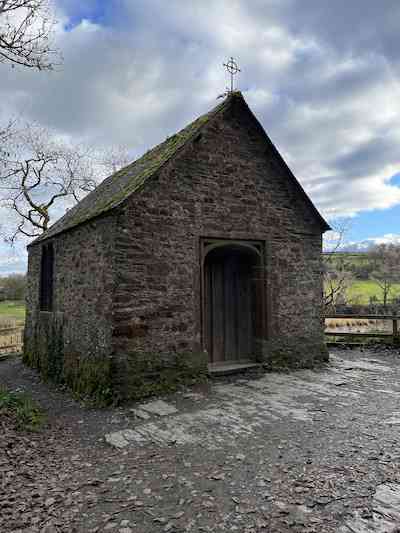
The Chapel in the Woods, also known as the Chapel of SS George and Thomas Becket, was constructed by Sir Richard Edgecumbe during the same period when he was making significant alterations to Cotehele House. This small chapel, with its whitewashed walls, a simple wooden altar table, remnants of medieval stonework, and a handful of benches (some of which still display worn 15th-century carved ends), has acquired a legendary status. It is said that Richard Edgecumbe erected the chapel as an expression of gratitude for narrowly escaping death on that very spot.
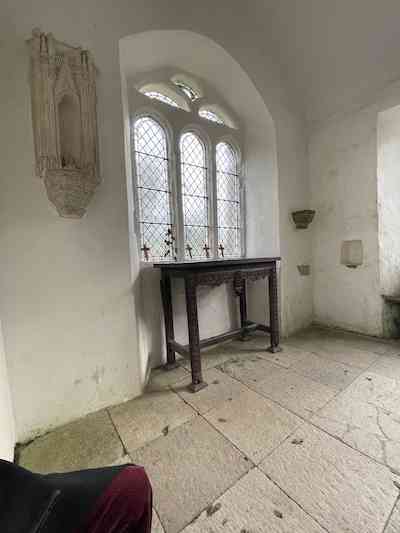
Richard Edgecumbe, an MP for Tavistock in Devon from 1467 to 1468, supported the house of Lancaster. Somuch so that his lands were seized by Edward IV, the Yorkist King, in 1471, to be returned a year later.
In 1483, angry about Richard III's seizure of the crown and concerned about the fate of Edward IV's two sons. Edgecumbe decided to join a rebellion led by Henry Stafford, 2nd Duke of Buckingham, Although Buckingham had initially supported Richard Duke of Gloucester in claiming the throne, he soon conspired with the Lancastrians to overthrow him. As a descendant of Edward III through John of Gaunt, Buckingham may even have had his own aspirations for the throne.
Lady Margaret Beaufort, the mother of Henry Tudor, Elizabeth Woodville and others, were involved in a plan to help Henry Tudor claim the throne with the support of Buckingham's forces. However, they did not take account of the unfavourable weather conditions. Incessant rain in mid-October led to severe flooding along the River Severn with many bridges destroyed, making it impossible for Buckingham to bring his army into England. Additionally, Henry Tudor's ships were delayed by storms. The rebels became disheartened and returned to their homes.
After the rebellion was quelled, Buckingham fled but was eventually caught and beheaded. Margaret Beaufort, was put under house arrest along with her husband Thomas Stanley, and the king confiscated her properties. Richard Edgecumbe hurried back to Cotehele, closely pursued by the king's men, who were led by his arch rival, Sir Henry Trenowth of Bodrugan, who had orders to arrest him.
Born in 1426, by all accounts Bodrugan was a violent and unruly man, variously accused of leading gangs who robbed his rivals’ houses, attacked tin stream works and ambushed merchants. Ships he owned at Fowey were involved in piracy, once chasing a Breton ship into St Ives and stealing a cargo of wine and cloth. A.L.Rowse described him as unstable, lawless, generous and extravagant, but hot-tempered; in Rowse’s words he was ‘a buccaneer’. Perhaps the fact that Henry Trenowth’s father died when Henry was still very young and a resulting lack of guidance might be blamed for his wayward ways in later life.
There was definitely no love lost between Edgecumbe and Bodrugan, and given Bodrugan's violent nature, Edgecumbe must have genuinely feared for his life as he approached Cotehele. Instead of hiding within the house, he made the daring decision to attempt an escape. With Bodrugan's men hot on his trail, he sprinted down the densely wooded slopes that descended sharply from the house towards the banks of the River Tamar. Upon reaching the river, he sought refuge in the undergrowth beneath the trees and waited, hoping for one last opportunity to elude his pursuers. Thinking quickly, Edgecumbe filled his hat with stones and flung it as far as he could towards the river. The stones created a loud splash when they hit the water, capturing the attention of Bodrugen and his men. Seeing the floating hat and no sign of Edgecumbe resurfacing, they assumed that he had drowned while attempting to swim across the river to safety. The king's men left, allowing Edgecumbe to complete his escape down the Tamar and board a ship in Plymouth bound for France. There, he joined Henry Tudor and his supporters in Brittany.
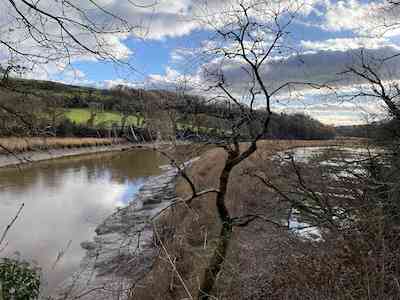
Two years later, Edgecumbe stood by Henry Tudor's side as they emerged victorious over Richard III at the Battle of Bosworth. Shortly after the battle, Edgecumbe was knighted. There were rumours that Bodrugan had fought alongside Richard III on the battlefield but, realising their cause was lost, fled to Cornwall for his own safety. On 8 February 1487, King Henry VII granted a commission to arrest Bodrugan, his son, and other rebels. Sir Richard Edgecumbe must have relished the opportunity to turn the tables on his old enemy. Together with John Trevanion of Caerhays, he set off in pursuit of Bodrugan. According to one account, they tracked him to the rocky coastline and managed to corner him on the cliffs at the point now famously known as Bodrugan's Leap. Bodrugan, it’s said, jumped from the cliff into the sea, where he had a boat waiting to carry him away to safety.
In November 1487 the Bodrugan estate was confiscated. Some might say it was poetic justice that Sir Richard Edgecumbe was gifted the lion’s share. He was well rewarded for his support for Henry VII and made Comptroller of the Kings Household, Constable of Launceston Castle , controller of the King’s silver mines in Devon and Cornwall and was also granted extensive lands.
Sir Henry Bodrugan was charged with ‘imagining and compassing the death of the king’, an offence punishable by death. Consequently, he spent the rest of his life abroad, possibly with relatives in Ireland. He is said to have either died there in around 1490, or in France 1502. What happened to his son John is a mystery. With their exile, the line of the Bodrugan family ended.
Meanwhile, back in Cornwall, Sir Richard could reclaim his estate at Cotehele and start work on his ambitious plans to expand and rebuild the house. To give thanks for his escape on the banks of the Tamar, sometime between 1485 and 1490, he built a small single-cell chapel at the spot where he had cast his hat into the river.
In the summer of 1588, Sir Richard was sent to Ireland to take the oaths of the AngloIrish lords following the Lambert Simnel rebellion. Amazingly, a journal recording his voyage from Cornwall to Kinsale, Waterford and Dublin and the proceedings there has survived. Sir Richard died 8 Sep 1489 in Morlaix, France, where he had been sent on a diplomatic mission.
The Chapel in the Woods measures only 6.3 metres by 4.6 metres and is built of coursed slate and stone rubble. Above the doorway is a wooden panel placed here during a restoration in 1769, recounting the tale of Sir Richard's escape and the founding of the chapel.

Addendum: a tangled web of family connections
As is always the case, once you scratch the surface, the connections between the complex network of powerful west country families emerge. It’s no surprise to find complicated connections between the Edgecumbe and the Champernowne, Carew and Raleigh families.
Richard Edgecumbe, born around 1443, married Joan Tremayne, daughter of Thomas Tremayne of Collacombe, in the parish of Lamerton, Devon and his wife, Elizabeth Carew. Elizabeth was the daughter of Thomas Carew (d1461) of Mohuns Ottery. Thomas Carew was the 3x great grandfather of Katherine Raleigh. (Katherine from my novel A Woman of Noble Wit)
Richard’s son, Piers Edgecumbe married Jane Dynham. (After the death of William Champernowne, Katherine Raleigh’s 3x great grandfather on the other side, his widow remarried into the Dynam family.) Piers Edgecumbe became one of the leading figures in the south-west during the first half of the sixteenth century. He was knighted during the festivities at court celebrating the future Henry VIII’s creation as Duke of York, and served as sheriff of either Devon or Cornwall eight times. He fought against Perkin Warbeck and, in 1513, he accompanied Henry VIII to France (alongside Katherine Raleigh’s grandfather Sir Edmund Carew.) Seven years later he was back in France at the Field of Cloth of Gold. Finally in 1536, at the time of the Lincolnshire rebellion, he was ordered to Ampthill with two hundred men, along with, amongst others, Katherine Raleigh’s father, Sir Philip Champernowne. also ordered to bring his troops there. Following the dissolution, Sir Piers was in some dispute with Sir Philip concerning the grant of lands from Totnes Priory, but did not succeed.
Richard Edgecumbe’s daughter Elizabeth married Wymond Raleigh, and was the mother of Katherine Raleigh’s second husband Walter. When Wymond was only six, his father died and he became Richard Edgecumbe’s ward. This gave Edgecumbe the rights to Wymond’s lands and the rights over his marriage. Those rights passed to Sir Piers Edgecumbe on Sir Richard’s death. Wymond and Elizabeth had two children, Walter and Jane, who married into the Upton family. When Wymond reached his majority (age 21) he tried without success to get his lands back from Sir Piers Edgecumbe. Things then get even more complicated. Wymond was fined for failing to disclose a treason or abuse to the proper authorities and was forced to sell lands at Smallridge to cover the debt. Those lands were bought by John Gilbert of Compton (died 1539) and were eventually, in the 1550s, transferred to Katherine Raleigh as part of a complex series of land deals involving her son, John (later Sir John) Gilbert.
Elizabeth Edgecumbe died and Wymond remarried in 1513 or 1514, Jane, daughter of Sir Thomas Grenville by his second wife (his first was Isabel Gilbert of Compton, mother of Honor Grenville, Lady Lisle). After Wymond died in 1515 proceedings in chancery eventually compelled the Edgecumbe’s to give back the lands and Walter’s wardship. Walter then became the ward of Sir Nicholas Vaux, Sherif of Northamptonshire and, courtier and favourite of Henry VIII, until he came of age. The estate Walter eventually inherited was greatly depleted by the actions of the Edgecumbe family, which may go some way to explain his decision to rent a small farm near the village of East Budleigh.
All photos my own